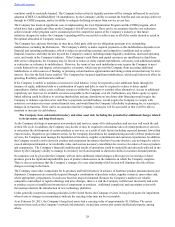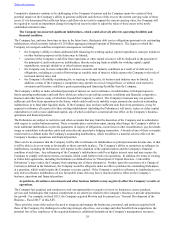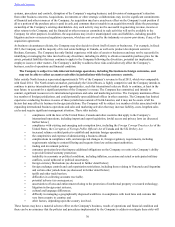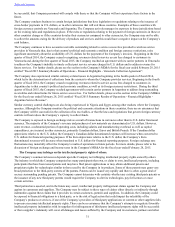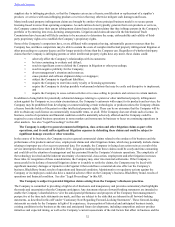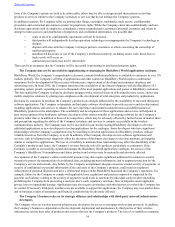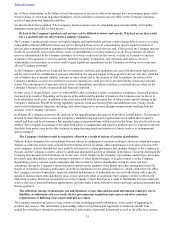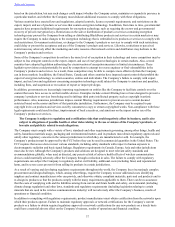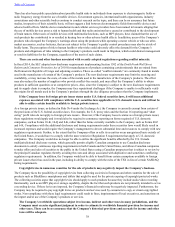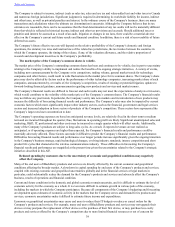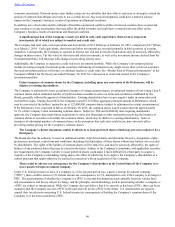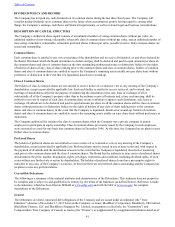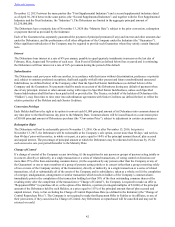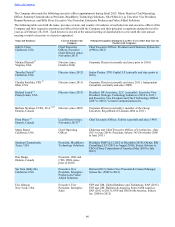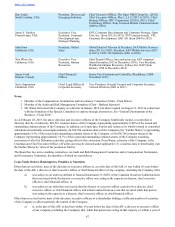Blackberry 2015 Annual Report Download - page 47
Download and view the complete annual report
Please find page 47 of the 2015 Blackberry annual report below. You can navigate through the pages in the report by either clicking on the pages listed below, or by using the keyword search tool below to find specific information within the annual report.
Table of Contents
38
There has also been public speculation about possible health risks to individuals from exposure to electromagnetic fields or
radio frequency energy from the use of mobile devices. Government agencies, international health organizations, industry
associations and other scientific bodies continue to conduct research on the topic, and there can be no assurance that future
studies, irrespective of their scientific basis, will not suggest a link between electromagnetic fields from mobile devices and
adverse health effects. Mobile device manufacturers and cellular services providers have been named in lawsuits alleging that
the use of mobile devices poses a risk to human health and that radio emissions have caused or contributed to the development
of brain tumors. Other users of mobile devices with multimedia functions, such as MP3 players, have claimed that the use of
such products has contributed to or resulted in hearing loss or other adverse health effects. In addition, users of the Company’s
products who disregard the Company’s warnings about using the products while operating a motor vehicle or who use after-
market accessories, such as batteries, that are not subject to the Company’s quality control procedures may also be at risk of
bodily harm. The perception of risk to human health or other risks could adversely affect the demand for the Company’s
products and allegations of risks relating to the Company’s products could result in litigation, which could distract management
or result in liabilities for the Company, regardless of the merit of such claims.
There are costs and other burdens associated with recently adopted regulations regarding conflict minerals.
In fiscal 2014, the SEC adopted new disclosure requirements implementing Section 1502 of the Dodd-Frank Wall Street
Reform and Consumer Protection Act of 2010 for manufacturers of products containing certain minerals that are mined from
the Democratic Republic of Congo and adjoining countries. These so-called “conflict minerals” are commonly found in metals
used in the manufacture of certain of the Company’s products. The new disclosure requirements may limit the sourcing and
availability, or may increase the costs, of some of the metals used in the manufacture of the Company’s products. The effect
may also reduce the number of suppliers who provide conflict-free metals, and may affect the Company’s ability to obtain
products in sufficient quantities or at competitive prices. Also, since the Company is subject to the new disclosure requirements
and its supply chain is complex, the Company may face reputational challenges if the Company is unable to sufficiently verify
the origins for all metals used in the Company’s products through the due diligence procedures that the Company implements.
If the Company loses its foreign private issuer status under U.S. federal securities laws, it will incur additional
expenses associated with compliance with the U.S. securities laws applicable to U.S. domestic issuers and will not be
able to utilize certain benefits available to foreign private issuers.
As a foreign private issuer, as defined in Rule 3b-4 under the Exchange Act, the Company is currently exempt from certain of
the provisions of the U.S. federal securities laws. For example, the U.S. proxy rules and the Section 16 reporting and “short
swing” profit rules do not apply to foreign private issuers. However, if the Company loses its status as a foreign private issuer,
these regulations would apply and it would also be required to commence reporting on forms required of U.S. domestic
companies, such as Forms 10-K, 10-Q and 8-K, rather than the forms currently available to the Company, such as Forms 40-F
and 6-K. Compliance with the additional disclosure and timing requirements under these securities laws would likely result in
increased expenses and would require the Company’s management to devote substantial time and resources to comply with new
regulatory requirements. Further, to the extent that the Company offers or sells its securities on an unregistered basis outside of
the United States, it would have to comply with the more restrictive Regulation S requirements that apply to U.S. domestic
companies. The Company would also no longer be able to utilize the significant benefits afforded by the U.S./Canada
multijurisdictional disclosure system, which generally permits eligible Canadian companies to use Canadian disclosure
documents to satisfy continuous reporting requirements in both Canada and the United States, and allows Canadian companies
to make offers and sales of securities to the public in the United States using a Canadian prospectus that is subject to review by
the principal Canadian regulator, thereby avoiding the costs and delays associated with duplicative and sometimes conflicting
regulatory requirements. In addition, the Company would not be able to benefit from certain exemptions available to foreign
private issuers that it has used in the past, including its ability to comply with the rules of the TSX in lieu of certain NASDAQ
listing requirements.
Copyright levies in numerous countries for the sale of products may negatively impact the Company’s business.
The Company faces the possibility of copyright levies from collecting societies in European and other countries for the sale of
products such as BlackBerry smartphones and tablets that might be used for the private copying of copyright protected works.
The collecting societies argue that copyright levies should apply to such products because they include audio/video recording
functionality, such as an MP3 player or storage capability, despite the fact that such products are not primarily intended to act as
a recording device. If these levies are imposed, the Company’s financial results may be negatively impacted. Furthermore, the
Company may be required to pay copyright levies on products and services used by consumers to copy or stream copyrighted
works. Non-compliance with these legal requirements could result in fines, imprisonment of local executives, and sanctions on
the import and/or use of the Company’s products or services.
The Company’s worldwide operations subject it to income, indirect and other taxes in many jurisdictions, and the
Company must exercise significant judgment in order to estimate its worldwide financial provision for income and
other taxes. There can be no assurance that the Company’s historical provisions and accruals for income and other
taxes will be adequate.


